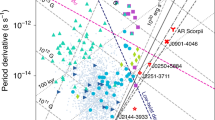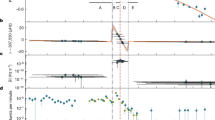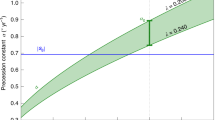Abstract
The alignment of Saturn’s magnetic pole with its rotation axis precludes the use of magnetic field measurements to determine its rotation period1. The period was previously determined from radio measurements by the Voyager spacecraft to be 10 h 39 min 22.4 s (ref. 2). When the Cassini spacecraft measured a period of 10 h 47 min 6 s, which was additionally found to change between sequential measurements3,4,5, it became clear that the radio period could not be used to determine the bulk planetary rotation period. Estimates based upon Saturn’s measured wind fields have increased the uncertainty even more, giving numbers smaller than the Voyager rotation period, and at present Saturn’s rotation period is thought to be between 10 h 32 min and 10 h 47 min, which is unsatisfactory for such a fundamental property. Here we report a period of 10 h 32 min 45 s ± 46 s, based upon an optimization approach using Saturn’s measured gravitational field and limits on the observed shape and possible internal density profiles. Moreover, even when solely using the constraints from its gravitational field, the rotation period can be inferred with a precision of several minutes. To validate our method, we applied the same procedure to Jupiter and correctly recovered its well-known rotation period.
This is a preview of subscription content, access via your institution
Access options
Subscribe to this journal
Receive 51 print issues and online access
$199.00 per year
only $3.90 per issue
Buy this article
- Purchase on Springer Link
- Instant access to full article PDF
Prices may be subject to local taxes which are calculated during checkout




Similar content being viewed by others
References
Sterenborg, M. G. & Bloxham, J. Can Cassini magnetic field measurements be used to find the rotation period of Saturn's interior? Geophys. Res. Lett. 37, 11201 (2010)
Smith, B. A. et al. A new look at the Saturn system: the Voyager 2 images. Science 215, 504–537 (1982)
Gurnett, D. A. et al. Radio and plasma wave observations at Saturn from Cassini’s approach and first orbit. Science 307, 1255–1259 (2005)
Gurnett, D. A. et al. The variable rotation period of the inner region of Saturn’s plasma disk. Science 316, 442–445 (2007)
Giampieri, G., Dougherty, M. K., Smith, E. J. & Russell, C. T. A regular period for Saturn’s magnetic field that may track its internal rotation. Nature 441, 62–64 (2006)
Sanchez-Lavega, A., Rojas, J. F. & Sada, P. V. Saturn’s zonal winds at cloud level. Icarus 147, 405–420 (2000)
Lindal, G. F., Sweetnam, D. N. & Eshleman, V. R. The atmosphere of Saturn—an analysis of the Voyager radio occultation measurements. Astrophys. J. 90, 1136–1146 (1985)
Anderson, J. D. & Schubert, G. Saturn’s gravitational field, internal rotation, and interior structure. Science 317, 1384–1387 (2007)
Read, P. L., Dowling, T. E. & Schubert, G. Saturn's rotation period from its atmospheric planetary-wave configuration. Nature 460, 608–610 (2009)
Zharkov, V. N. & Trubitsyn, V. P. Physics of Planetary Interiors 388 (Pachart Publishing House, 1978)
Hubbard, W. B. Planetary Interiors 1–343 (Van Nostrand Reinhold, 1984)
Schubert, G., Anderson, J., Zhang, K., Kong, D. & Helled, R. Shapes and gravitational fields of rotating two-layer Maclaurin ellipsoids: application to planets and satellites. Phys. Earth Planet. Inter. 187, 364–379 (2011)
Kaspi, Y., Showman, A. P., Hubbard, W. B., Aharonson, O. & Helled, R. Atmospheric confinement of jet streams on Uranus and Neptune. Nature 497, 344–347 (2013)
Jacobson, R. A. JUP230 Orbit Solutions http://ssd.jpl.nasa.gov/ (2003)
Jacobson, R. A. et al. The gravity field of the Saturnian system from satellite observations and spacecraft tracking data. Astrophys. J. 132, 2520–2526 (2006)
Hubbard, W. B. et al. Structure of Saturn’s mesosphere from the 28 SGR occultations. Icarus 130, 404–425 (1997)
Flasar, F., Schinder, P. J., French, R. G., Marouf, E. A. & Kliore, A. J. Saturn’s shape from Cassini radio occultations. AGU Fall Meet. Abstr. B8 (2013)
Helled, R., Schubert, G. & Anderson, J. D. Jupiter and Saturn rotation periods. Planet. Space Sci. 57, 1467–1473 (2009)
Helled, R. Jupiter’s occultation radii: implications for its internal dynamics. Geophys. Res. Lett. 38, 8204 (2011)
Helled, R. & Guillot, T. Interior models of Saturn: including the uncertainties in shape and rotation. Astrophys. J. 767, 113 (2013)
Guillot, T. The interiors of giant planets: Models and outstanding questions. Annu. Rev. Earth Planet. Sci. 33, 493–530 (2005)
Fortney, J. J. & Nettelmann, N. The interior structure, composition, and evolution of giant planets. Space Sci. Rev. 152, 423–447 (2010)
Dowling, T. E. Saturn’s longitude: rise of the second branch of shear-stability theory and fall of the first. Int. J. Mod. Phys. D 23, 1430006–86 (2014)
Higgins, C. A., Carr, T. D. & Reyes, F. A new determination of Jupiter’s radio rotation period. Geophys. Res. Lett. 23, 2653–2656 (1996)
Porco, C. C. et al. Cassini imaging of Jupiter’s atmosphere, satellites and rings. Science 299, 1541–1547 (2003)
Iess, L., Finocchiaro, S. & Racioppa, P. The determination of Jupiter and Saturn gravity fields from radio tracking of the Juno and Cassini spacecraft. AGU Fall Meet. Abstr. B1 (2013)
Finocchiaro, S. & Iess, L. in Spaceflight Mechanics 2010 Vol. 136, 1417–1426 (American Astronautical Society, 2010)
Clairaut, A. C. Traite de la Figure de la Terre, tiree des Principes de l’Hydrostatique (Paris Courcier, 1743)
Nocedal, J. & Wright, S. J. Conjugate Gradient Methods 102–120 (Springer, 2006)
Carter, J. A. & Winn, J. N. Empirical constraints on the oblateness of an exoplanet. Astrophys. J. 709, 1219–1229 (2010)
Kramm, U., Nettelmann, N., Fortney, J. J., Neuhäuser, R. & Redmer, R. Constraining the interior of extrasolar giant planets with the tidal Love number k2 using the example of HAT-P-13b. Astron. Astrophys. 538, A146 (2012)
Acknowledgements
We thank G. Schubert, M. Podolak, J. Anderson, L. Bary-Soroker, and the Juno science team for discussions and suggestions. We acknowledge support from the Israel Space Agency under grants 3-11485 (R.H.) and 3-11481 (Y.K.).
Author information
Authors and Affiliations
Contributions
R.H. led the research. R.H. and Y.K. initiated the research and wrote the paper. E.G. designed the optimization approach and executed all the calculations. R.H. computed interior models and defined the parameter space for the figure functions. All authors contributed to the analysis and interpretation of the results.
Corresponding author
Ethics declarations
Competing interests
The authors declare no competing financial interests.
Extended data figures and tables
Extended Data Figure 1 The flattening parameters calculated by the model without constraining the figure functions.
Shown are f, k, h for Saturn with ΔR = 50 km.
Extended Data Figure 2 An example of our statistical optimization model for deriving the rotation period.
The results are shown for a case for which the range of allowed rotation period is between 10 h 24 min and 10 h 54 min. The solution is based on a combination of 2,000 individual sub-cases, each of them representing a case with specific random initial conditions within the defined parameter space. a–c, A scatter plot (similar to Fig. 1a) of the distribution of solutions on the plane of the calculated rotation period Pcalc minus Pvoy versus each of ΔJ2, ΔJ4 and ΔJ6. Each blue dot represents one sub-case converged solution. In a the inner and outer black circles show the first and second standard deviations, respectively. d–j, The distribution of solutions for the figure functions K2, K3, H3, F1, F2 and F3, respectively.
Extended Data Figure 3 Saturn’s calculated rotation period versus the uncertainty in the assumed rotation period and radius.
Pcalc shown (colour scale) as a function of ΔP (h) and ΔR (km). The dashed line presents the transition from the regime where the constraint on the rotation period (above the dashed line) to the regime where the constraint on the shape is more dominant.
Extended Data Figure 4 Radial density profiles for two different interior models for Saturn (top) and Jupiter (bottom).
The black curves correspond to models with very large cores and the blue curves are no-core models in which the density profile is represented by 6th-order polynomials. For the massive-core case we assume a constant core density of ∼1.5 × 104 kg m−3, reaching 20% of the planet’s radius. The density profiles are constrained to match the planetary mass, J2, J4, J6, mean radius, and the atmospheric density and its derivative at 1 bar (see details in refs 8, 13 and 18). We then use the difference in the values of the figure functions in the two limiting cases to limit their values.
Extended Data Figure 5 The calculated flattening parameters when the figure functions are limited by interior models.
a–c, A scatter plot (similar to Fig. 1a) of the distribution of solutions on the plane of the calculated rotation period Pcalc minus Pvoy versus ΔJ2, ΔJ4 and ΔJ6, respectively. Each blue dot represents one sub-case converged solution. The calculated mean radius was set to be within 20 km of Saturn's observed mean radius. In a the inner and outer black circles show the first and second standard deviations, respectively. d–j, The distribution of solutions for the figure functions K2, K3, H3, F1, F2 and F3, respectively.
Rights and permissions
About this article
Cite this article
Helled, R., Galanti, E. & Kaspi, Y. Saturn’s fast spin determined from its gravitational field and oblateness. Nature 520, 202–204 (2015). https://doi.org/10.1038/nature14278
Received:
Accepted:
Published:
Issue Date:
DOI: https://doi.org/10.1038/nature14278
This article is cited by
-
Dynamics and clouds in planetary atmospheres from telescopic observations
The Astronomy and Astrophysics Review (2023)
-
Uranus and Neptune are key to understand planets with hydrogen atmospheres
Experimental Astronomy (2022)
-
The turbulent dynamics of Jupiter’s and Saturn’s weather layers: order out of chaos?
Geoscience Letters (2020)
-
How Well Do We Understand the Belt/Zone Circulation of Giant Planet Atmospheres?
Space Science Reviews (2020)
-
Comparison of the Deep Atmospheric Dynamics of Jupiter and Saturn in Light of the Juno and Cassini Gravity Measurements
Space Science Reviews (2020)
Comments
By submitting a comment you agree to abide by our Terms and Community Guidelines. If you find something abusive or that does not comply with our terms or guidelines please flag it as inappropriate.



